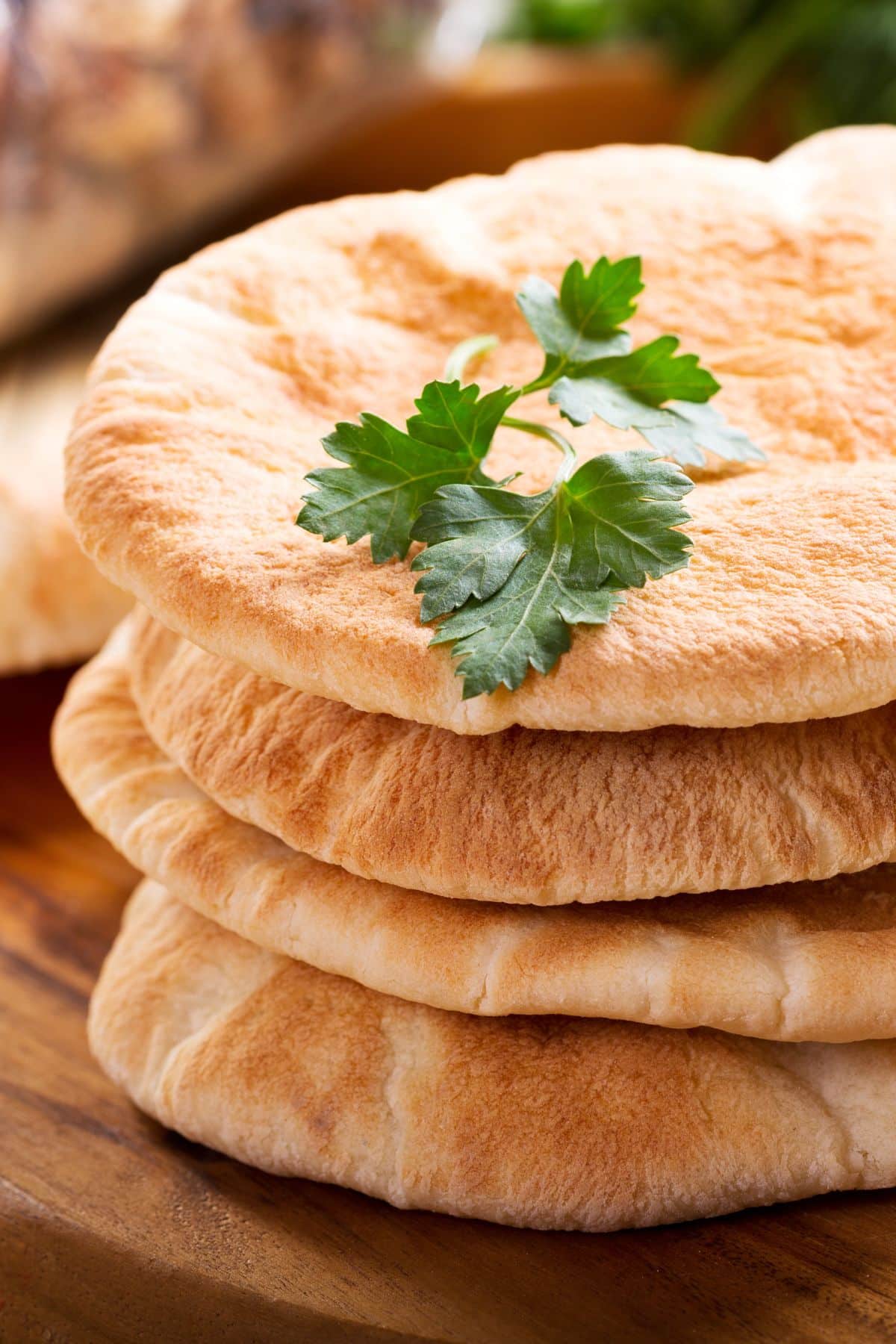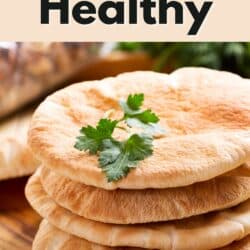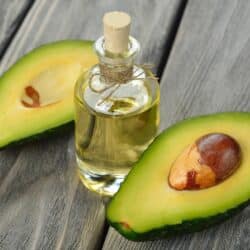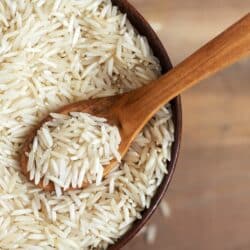Is Pita Bread Healthy (From A Nutritionist)?
In this blog post, I’ll review whether pita bread is healthy or not? Find out what the nutrition pros and cons of pita bread are and what other options you can consider. For most people, pita bread enjoyed in moderation is not bad for you and may be a healthy option.

Pita Bread Overview
Pita bread is a popular type of leavened flatbread that has been around for thousands of years. It originated in the Middle East and is traditionally made from a simple mixture of flour, water, yeast, and salt.
Its unique flavor and texture make it a versatile ingredient. You can serve pita bread in many different dishes and in various ways.
Pita bread is different from other types of white bread or whole wheat bread in several ways.
It has fewer ingredients than other types of bread, and it is baked differently, giving it a unique texture and flavor. To make pita bread, you roll the dough into thin circles and then bake it at a high temperature for a short period.
Unlike some other types of regular bread prepared in a loaf that requires slicing, pita bread has a pocket in the middle, formed when the pita dough puffs up during baking. It’s perfect for filling with meat, veggies, salads, or anything else you like.
Pita bread is also excellent for dipping into sauces and spreads like tzatziki, hummus, and baba ganoush. You can grill or toast it for a crispy texture and enhanced flavor.
General Ingredients for Pita Bread
The main ingredients for making pita bread are flour, yeast, water, and salt.
Here is some more information about the main components of this versatile bread and tips for using the optional ingredients.
Flour
The most commonly used flour for pita bread is a combination of all-purpose flour (white flour), whole wheat, and bread flour, or just one of them.
All-purpose flour helps soften the pita, while whole wheat flour adds nutrients, fiber, flavor, and color.
Yeast
Most pita recipes call for active dry yeast, which has to be activated in warm water.
Some recipes include a little sugar or honey to help activate the yeast. The sweetness can also enhance the pita bread’s flavor. Another option is to use instant yeast.
Water
When you use active dry yeast, it’s essential to use warm water to activate it.
If you want pita bread with a softer texture, you can use milk instead of water to activate the yeast and make the dough; either option will work.
Salt
As with any bread, salt is critical for flavor. You can use any salt you like.
Olive Oil (optional)
Some recipes call for a small amount of olive oil to make the dough more pliable and to give the bread a slightly richer flavor. If you’re using olive oil, it’s best to use extra virgin olive oil for the best nutritional benefits and flavor.
High-quality extra virgin olive oil is loaded with heart-healthy fats and antioxidants and can help protect against heart disease, inflammation, breast cancer, and diabetes.
Nutrition Pros
Pita bread is low-fat and relatively lower in calories than other bread.
Making whole grain pita bread with whole wheat flour can be a good source of whole grains, which are rich in fiber and essential nutrients.
Besides the nutritional pros, pita bread is versatile and convenient. It makes it easier to have a relatively healthy meal on the go with minimal prep.
Homemade healthy pita bread made with whole-wheat flour is likely a healthier option than anything you can buy at the grocery store.
Nutrition Cons
While pita bread can provide some nutritional benefits, there are also potential drawbacks.
Pita bread traditionally contains wheat flour, which contains gluten. This can be a problem for people who are gluten intolerant or have celiac disease.
For those watching their carbohydrate intake, pita bread is relatively high in carbohydrates and low in grams of protein. It is not appropriate for a low-carb diet as it contains quite a few grams of carbs in each serving.
Eating it in moderation and with other healthy, balanced, and real food ingredients is best. This can help minimize changes in blood sugar levels.
If you are eating store-bought pita bread, some brands may contain processed ingredients like preservatives, added sugars, artificial flavors, and sweeteners. They may also have a high sodium content.
It’s best to make pita bread at home, where you have control over the ingredients, or at least to take special care to check the nutrition information on the label before you buy and eat it.
And, as always, if you have questions about whether o not pita bread is appropriate for you, it’s best to ask your healthcare provider as I can’t provide medical advice.
Nutrition FAQs
Pita bread can be healthy if you’re not gluten intolerant, have celiac disease, or are sensitive to yeast. It’s low in fat and can be a good source of whole grains if it is made with whole wheat flour.
However, it is high in carbohydrates and does not contain significant protein, so it is essential to eat it in moderation paired with other nutrient-dense real food ingredients.
To ensure you’re optimizing the nutritional value of pita bread, try to buy types of pita bread that do not contain artificial ingredients, preservatives, added sugar, or high quantities of sodium. Or, better yet, make your own using healthy ingredients.
Yes, most pita bread is a good source of fiber. The amount of fiber in pita bread may vary depending on the recipe or brand. On average, one whole wheat pita bread can provide around 2-5 grams of fiber, which is about 8-20% of the recommended daily intake for adults.
It depends. Everyone is different. Pita bread may have fewer calories than other sources of carbohydrates such as pita chips or potato chips. Speak to your healthcare provider to determine whether pita bread has enough health benefits for you. Whole wheat pita bread is a source of complex carbohydrates.
Homemade bread without preservatives is likely a healthier type of bread than many store-bought brands. Consider making your own sourdough bread, rye bread, pita bread, or other types of whole grain breads using whole grain flour. For a gluten-free diet, you will need to use gluten-free baking mixes.
More Food and Product Reviews You Might Like
Conclusions
Pita bread is a flatbread made with minimal ingredients. Overall, pita bread can be a nutritious option for those looking for a low-fat, low-calorie, high-fiber, and whole-grain bread option.
However, it’s essential to remember that not all pita bread is created equal. Be sure to check the ingredients list and nutrition information when selecting a brand, or better yet, make it at home with healthy ingredients. It is also important to note that pita bread is unsuitable for people with gluten sensitivity or celiac disease.
Don’t forget to join my newsletter list to get exclusive clean eating recipes and tips. The newsletter is 100% free with no spam; unsubscribe anytime.
About the Author: Carrie Forrest has a master’s degree in public health with a specialty in nutrition and is a certified holistic nutritionist. She is a top wellness and food blogger with over 5 million annual visitors to her site. Carrie has an incredible story of recovery from chronic illness and is passionate about helping other women transform their health. Send her a message through her contact form.
Note: this post is for informational purposes only and is not intended as medical advice. Please consult your healthcare provider for recommendations related to your individual situation.




















